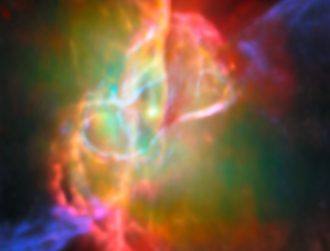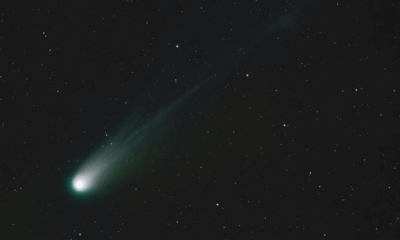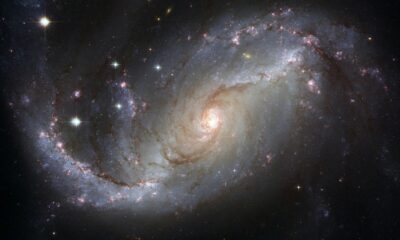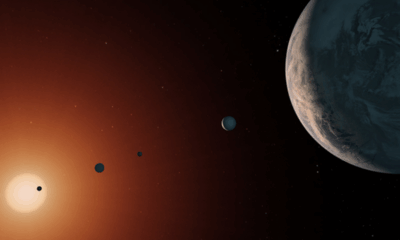Science
James Webb Telescope Reveals Secrets of the Butterfly Nebula

The James Webb Space Telescope has made a groundbreaking discovery regarding the Butterfly Nebula, revealing details about its central star that were previously unknown. This planetary nebula, located approximately 3,400 light-years away in the Scorpius constellation, is one of the most studied nebulae in the Milky Way galaxy and has now been captured in unprecedented detail.
Despite its name, the term “planetary nebula” does not relate to planets. Historically, astronomers used this term when they observed these objects appearing round in the sky. The Butterfly Nebula, however, defies this description with its striking, non-spherical shape resembling butterfly wings. It is classified as a bipolar nebula, characterized by two lobes extending in opposite directions.
New Insights from Mid-Infrared Observations
Utilizing the Mid-InfraRed Instrument (MIRI), Webb’s latest images focus on the nebula’s core, revealing a “never-before-seen” portrait of this magnificent celestial body. The MIRI is capable of capturing images across multiple wavelengths simultaneously, allowing scientists to analyze how the nebula’s appearance changes under different conditions.
In conjunction with the observations from Webb, researchers employed data from the Atacama Large Millimeter/submillimeter Array, leading to the identification of nearly 200 spectral lines. Each of these lines provides critical information about the various atoms and molecules present within the nebula.
One significant finding is the precise location of the Butterfly Nebula’s central star, which had eluded scientists until now. This star is surrounded by a previously undetected heat dust cloud, which emits a brilliant glow at the mid-infrared wavelengths. With a staggering temperature of 220,000 Kelvin, this star ranks among the hottest known central stars in planetary nebulas.
Discovery of Carbon-Based Molecules
Another intriguing aspect of Webb’s findings is the detection of light emitted by carbon-based molecules known as polycyclic aromatic hydrocarbons, or PAHs. On Earth, PAHs are commonly associated with sources such as campfire smoke and car exhaust. This discovery may represent the first evidence of PAHs forming in an oxygen-rich planetary nebula, further enhancing our understanding of these complex celestial environments.
This latest research from the James Webb Space Telescope not only sheds light on the Butterfly Nebula but also aligns with broader studies in the field. Earlier this month, a study led by the University of St Andrews suggested that free-floating planets could potentially create miniature planetary systems independent of a host star.
As scientists continue to unravel the mysteries of the universe, the James Webb Space Telescope stands at the forefront, providing invaluable insights into the life cycles of stars and the formation of complex molecules in space. The discoveries made through this mission enhance our understanding of the cosmos and its intricate phenomena.
-

 Entertainment2 months ago
Entertainment2 months agoAnn Ming Reflects on ITV’s ‘I Fought the Law’ Drama
-

 Entertainment3 months ago
Entertainment3 months agoKate Garraway Sells £2 Million Home Amid Financial Struggles
-

 Health2 months ago
Health2 months agoKatie Price Faces New Health Concerns After Cancer Symptoms Resurface
-

 Entertainment2 months ago
Entertainment2 months agoCoronation Street’s Carl Webster Faces Trouble with New Affairs
-

 Entertainment2 months ago
Entertainment2 months agoWhere is Tinder Swindler Simon Leviev? Latest Updates Revealed
-

 Entertainment3 months ago
Entertainment3 months agoKim Cattrall Posts Cryptic Message After HBO’s Sequel Cancellation
-

 Entertainment2 months ago
Entertainment2 months agoOlivia Attwood Opens Up About Fallout with Former Best Friend
-

 Entertainment2 months ago
Entertainment2 months agoMasterChef Faces Turmoil as Tom Kerridge Withdraws from Hosting Role
-

 Entertainment3 months ago
Entertainment3 months agoMarkiplier Addresses AI Controversy During Livestream Response
-

 Entertainment4 months ago
Entertainment4 months agoSpeculation Surrounds Home and Away as Cast Departures Mount
-

 World2 months ago
World2 months agoCole Palmer’s Mysterious Message to Kobbie Mainoo Sparks Speculation
-

 Entertainment2 months ago
Entertainment2 months agoITV’s I Fought the Law: Unraveling the True Story Behind the Drama

















